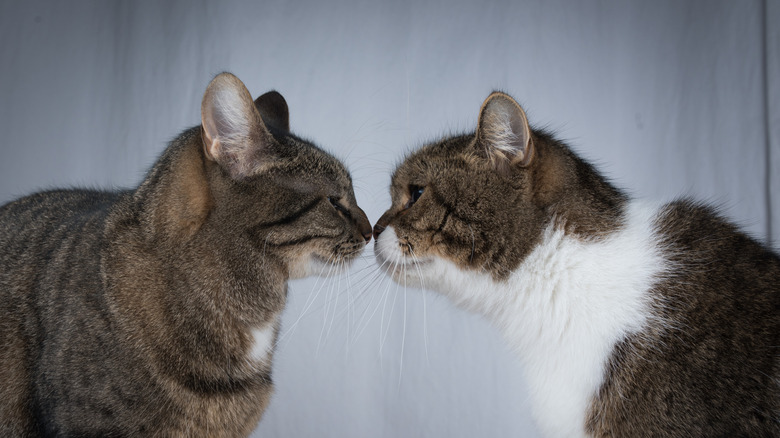Why Do Cats Touch Noses?
When cats bump noses, it may seem like they are giving each other a kiss, but this action is a form of greeting. Whether they touch noses with one another or bunt you with their head, body language is one of the main ways cats communicate with the beings around them.
Cats rarely meow when not interacting with humans, so with one another, other than hissing or yowling, physical communication is how most conversations are had. Sniffing, whether faces or body parts, and bunting with their head helps cats gather information about people and animals they greet. Some cats' behaviors can mean different things, so it's crucial to observe the whole situation when a feline approaches you to find out what he is trying to say.
How cats greet one another
Cat greetings begin with face-to-face physical interaction. This action may seem simple, but the process brings a release of pheromones that helps them get to know one another through a form of chemical communication. Cats also sniff one another's butts as a greeting.
Smell is an important way for cats to assess a situation due to their Jacobson's organ, a vessel behind their nasal passage that works with their olfactory system to absorb information through picking up difficult-to-detect odors. The biochemical compounds, which share a cat's preference and mood, are these hard-to-smell aromas that help cats carry on a chemical conversation together.
So, when cats touch noses, is it a good sign? The answer is that it depends. All cats will do this to say hello but pay attention to how they are acting during and afterward to see if they've had a positive introduction.
Cats touching your face
If you're wondering, "Why does my cat rub his face on me in the morning?" and the reason for cats touching noses with humans, the answer can mean multiple things. Cats touching your face may want you to get out of bed and feed them or play with them. Also, a cat rubbing her wet nose on you could just be her way of saying hello.
When cats bunt, or rub you with their face, they are claiming you and leaving their scent on you. While this can be a social gesture, it is often territorial and a way to let other cats know something or someone belongs to them. They may also be using this affectionate gesture to let you know they care for you and see you as a safe space.
Cats who bunt because they feel threatened may take things a step farther by marking or scratching. Look at your cat's situation. See if her environment is causing stress and if so, give your cat more space. Your cat may feel overwhelmed or on the opposite spectrum, crave more attention.
How to react
Knowing the right way to react when a cat comes up to you is important. With a new feline, be gentle and respectful. Start your introduction by offering your finger for him to smell to get to know you. See what he does. Cats like it when you touch their paws some of the time but be cautious around a cat who is still getting comfortable with you. Avoid petting the belly of a cat you do not know because while some cats may enjoy this, most are protective of their stomach and will get upset at it being touched.
Signs of emotions in cats
Putting their face in your face and giving you nose "boops" is how cats act friendly with people and other animals, but they have many other ways of communicating how they are feeling with those around them. Purring tends to mean a cat is happy in most cases, though sometimes, it can indicate a different emotion. Cats purr when they're content or as a way to calm down if they are feeling stressed or anxious. If a cat looks at you and closes her eyes, it's a way of saying she loves you. Cuddles are also a way that felines show affection. Happy cats will sit, stand, or lay down calmly with their tail curled.
Most cat emotions are expressed through body language and changes to their posture, tail, and ears. A cat who is angry or upset will have a puffy tail and will put her ears down. This indicates anger and fear, and if your cat does this, you should stop what you are doing and give her space.
Prior to this, you can tell a cat is becoming agitated if she moves her tail quickly. While in dogs tail wagging usually means excitement, in cats, it is a sign that they are starting to get upset. A tail straight up is friendly, and if your cat's tail makes a hook, she is feeling curious.
